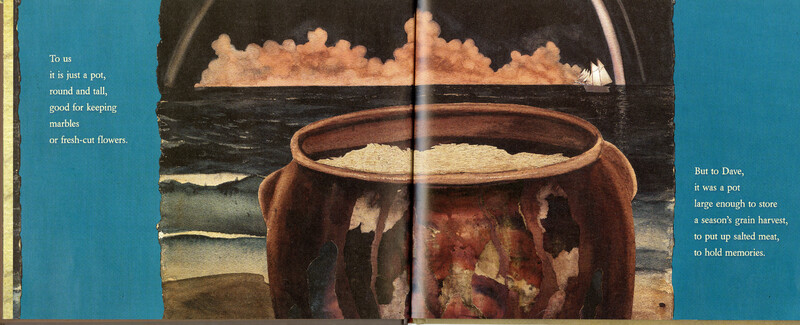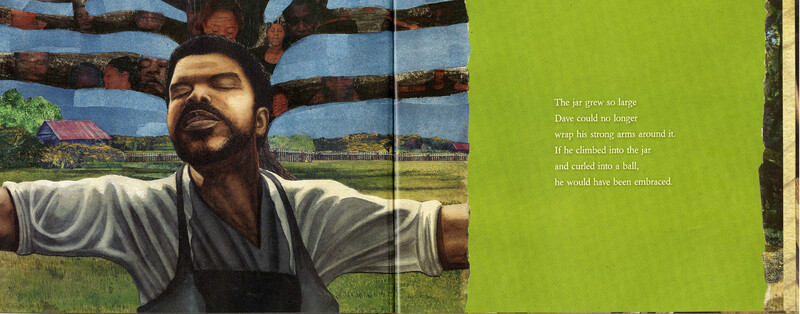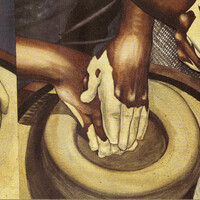Dave the Potter: Poet, Artist, Slave
Item- Title
- Dave the Potter: Poet, Artist, Slave
- Description
-
Dave the Potter is one of many contemporary picturebook production stories for children that explain how something was made in the past. Another example is Marguerite Makes a Book by Bruce Robertson, illustrated by Kathryn Hewitt, about a girl who makes an illuminated manuscript; A Fine Dessert by Emily Jenkins, illustrated by Sophie Backall, about making a blackberry and whipped cream treat; and Blacksmith’s Song by Elizabeth Van Steenwyk, illustrated by Anna Rich, about the son of an enslaved blacksmith, who assists his father in the forge and helps freedom seekers. Picturebooks about making things in the past are either told from the perspective of a child who learns how to make something, or they are exemplary biographies of famous artists, musicians, and artisans.
Dave the Potter tells the biography of David Drake, an enslaved master potter responsible for managing the operations of a pottery manufactory in the Edgefield District of South Carolina. Based on the latest designs, his industrial sized kiln made massive pots used to store grain and salted meats to feed the growing regional population of enslaved persons. The picturebook thus engages with both ceramics and basic food supplies, both commodities often treated in production books. David Drake signed many of his pots “Dave,” adding short poems of rhymed couplets, even though it was against the law for an enslaved person to read or write. Today, his creations are collected in museums for public viewing (Chaney, 2018).
The picturebook shows how Dave makes his pots and his poems but avoids erasing his personality and skills by balancing close-ups on Dave’s hands with meditative images of Dave’s face and creative productions. The quadriptych close-ups on Dave’s hands, for instance, which appears mid-book, showcases his craft expertise. Like Dave, readers pull out the book’s page to view the full spread, just as Dave “pulls” his pot from the pottery wheel. Another spread from two pages later shows Dave’s face, with eyes closed, hands thrown wide like Christ to embrace readers, while behind him the faces of Dave’s people stretch out from his mind like an ancestral tree. In both cases, Dave’s creativity is connected to a long history of African Diaspora cultures, that embraces his ancestors but also readers.
By involving readers in Dave’s creative enterprise, the picturebook time slips between present-day readers, Dave’s work in the kiln, and Dave’s own past. This Afrofuturist approach brings recipients of David Drake’s art, including readers, to his South Carolina shores, where they can positively identify with his creative spirit but cannot forget the tragedy of his captivity. The picturebook’s multi-temporal setting is doubly fitting because of what Dave writes on this particular pot, which readers only learn on the final spread: “I wonder where / is all my relation / friendship to all— / and, every nation.” Having read Dave’s poetry, readers can turn back time themselves, by turning back the pages of the book, to find the same sentiments foreshadowed on the opening spread: a large pot transposed on a dark Atlantic Ocean, where a single ship recalls the middle passage. Instead of the sky above, viewers look down into the pot’s stored contents, the brown rim of the pot arching like a rainbow’s promise. Remembrance and hope, sealed away, opened later. Perhaps these are the images in Dave’s mind as he made this pot, wondering about “all my relation.”
- Creator
- Hill, Laban Carrick
- Contributor
- Brian Collier (illustrator)
- Date
- 2010
- Subject
- biography
- production story
- pottery
- contemporary children's literature
- Rights
- Text copyright 2010 by Laban Carrick Hill. Illustrations copyright 2010 by Brian Collier. Text and images used under fair use.
- Identifier
- University of Illinois Library, Urbana-Champaign, Call Number: Q. SB. D272h
- Bibliographic Citation
- Hill, Laban Carrick and Collier, Brian. (2010). Dave the Potter: Poet, Artist, Slave. New York: Little, Brown.





